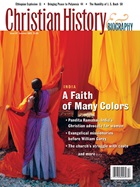The pioneering English missionary William Carey had a dream: that in 1810 a World Missionary Conference would be held in which Christians would come together in unity around the common purpose of world evangelization.Exactly 100 years later, that dream became a reality. In 1910, an unprecedented gathering of 1200 representatives from missionary societies all over the world met in Edinburgh for the purpose of discussion, cooperation, and mobilization.The chairman of the conference, John R. Mott, had inspired the Student Volunteer Movement with the slogan, "The Evangelization of the World in This Generation. For those in Edinburgh, it almost seemed possible."
The 1910 World Missionary Conference was called to order on the evening of June 13 at the Assembly Hall of the United Free Church of Scotland, in the shadow of Edinburgh's famous castle. After an opening prayer, the president of the conference, Lord Balfour of Burleigh, read greetings from the Imperial German Colonial Office, from former U.S. President Theodore Roosevelt, and from King George V of England,the upright sovereign who only a month before had succeeded his dissolute father Edward VII to the British throne. After the last greeting, the delegates arose spontaneously to sing "God Save the King."
During the speeches that followed, Lord Burleigh voiced the hope that "a unity begun in the mission field may extend its influence, and react upon us at home and throughout the old civilizations." The archbishop of Canterbury expressed the opinion that some at that meeting "might not taste death till they see the Kingdom of God come with power." And the American missionary statesman Robert E. Speer challenged the delegates to remember that no one can follow Christ "without following Him to the uttermost parts of the earth" and urged them to believe that "living faith will make it possible for Him [Christ] to use us for the immediate conquest of the world."
For the next ten days, dramatic speeches were interspersed with wide-ranging debate. The conference took up eight separate subjects: the transport of the gospel to the whole non-Christian world, the church in the mission field, the place of education in national Christian life, the message of Christian missions in relation to non-Christian faiths, the preparation of missionaries, the home base of missions, missions and governments, and the promotion of Christian unity. For each new theme there was a full volume of published reports, drawing liberally from over 1000 extensive questionnaires that had been returned by missionaries.
Distinguished British, American, and European missionaries from around the globe led the discussions, which were often enlivened by recitations of missionary experience itself. The conference ended with the shared conviction that the gathering was too important simply to let slip away.
Ecumenism and expansion
Discussions begun at Edinburgh in 1910 did in fact continue. Eventually they led to the establishment of the International Missionary Conference, and less directly to two organizations that eventually merged in 1948 to create the World Council of Churches. The missionary conference in Edinburgh was, therefore, the beginning of the 20th- century ecumenical movement.
It also represented the high tide of Western missionary expansion, which had gathered strength throughout the 19th century. In that century—when first Britain filled a vacuum of worldwide leadership and then the United States emerged as a great economic power and shaper of civilization—the proportion of the world's population associated with Christian churches increased more rapidly than at any time since the fourth century. Where less than a quarter of the world could be identified as Christian in 1800, almost 35 percent could be so numbered at the time of the Edinburgh Conference.
The zeal of Robert Speer and the optimism of the archbishop of Canterbury were thus understandable. The delegates at Edinburgh had lived through an unprecedented expansion of the church, much of it the direct result of missionary efforts. It seemed as if they had a right to rejoice, to anticipate the speedy completion of the Great Commission, and even to assume that this great task would be brought to its end under the leadership of the Protestants responsible for the Edinburgh Conference.
The true turning point
But if Edinburgh marked a high point, it was also, in the phrase of mission historian Stephen Neill, "the end of an epoch." It was a conference on the worldwide mission of the "church," but only Protestants attended. Even more, it was a meeting to discuss the evangelization of the world, but over 80 percent of the approximately I ,200 delegates were from Britain and America, with only 170from the European Continent and only 18 representing the world beyond Europe and North America.
As of 1910 in Edinburgh—or New York, Chicago, Los Angeles, Toronto, Berlin, or Copenhagen—worldwide Christianity" still meant a Christianity reaching out from Europe (and its North American extensions) to the rest of the globe. But not for long. The wave of the future was toward a world Christianity defined as much outside of Europe and North America as by Europe and North America. The wave of the future was the indigenization of Christianity in countless regional cultures around the world. The wave of the future pointed toward the Lausanne Conference on World Evangelization in 974, when 2,700 delegates, including at least half from the Two-Thirds World, gathered from I 5 I different countries to discuss a theme that over the course of the 20th century was becoming a reality.
The Edinburgh Missionary Conference of 1910 represents a great turning point in the history of Christianity not so much because of what was done by its delegates, but because it symbolized a dawning consciousness concerning the worldwide extension of the faith. Hindsight shows that the delegates were foolish to think that Christian expansion would replicate a faith that looked pretty much as it appeared in the precincts of Scotland's United Free Church Assembly Hall. But they were far from foolish in being optimistic about the reality of that expansion.
While the Western missions represented at Edinburgh would do their part, it was the appropriation of Christianity by peoples literally around the world that marked the crucial turning point.
This article is adapted from Mark Noll's book Turning Points: Decisive Moments in the History of Christianity (Baker Academic, a division of Baker Publishing Group, 1997.) Used by permission.
All rights to this material are reserved. Materials are not to be published in other media without written permission from Baker Publishing Group.
Copyright © 2005 by the author or Christianity Today/Christian History magazine.
Click here for reprint information on Christian History.

Support Our Work
Subscribe to CT for less than $4.25/month




























